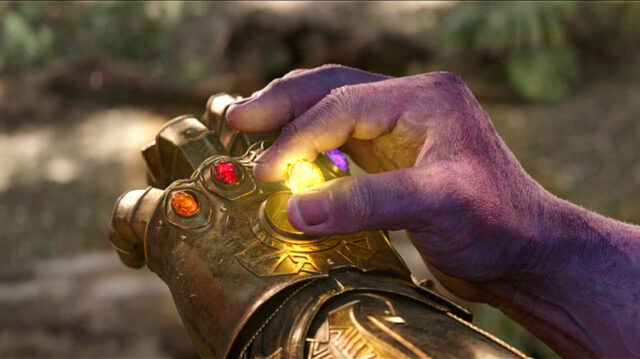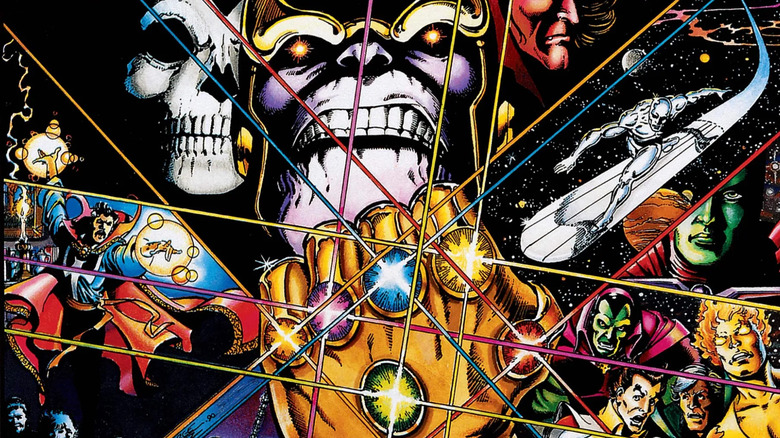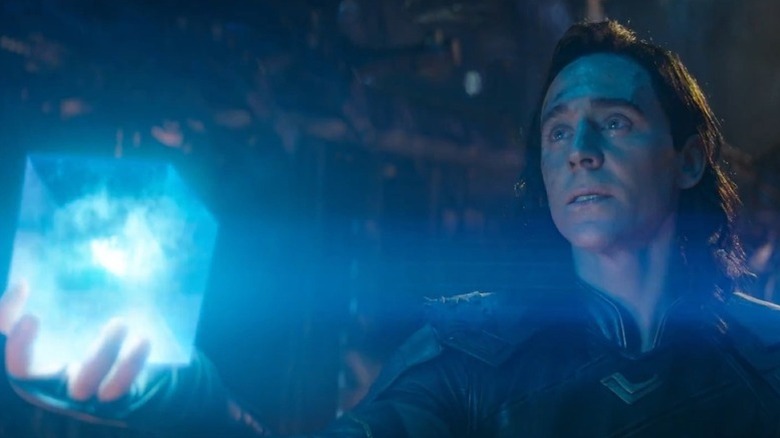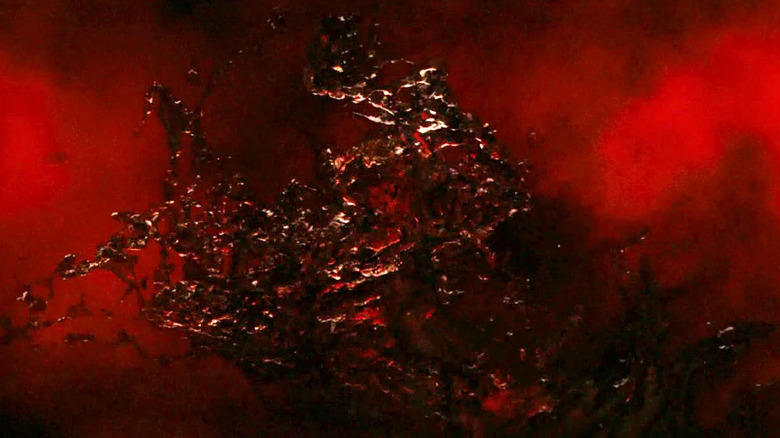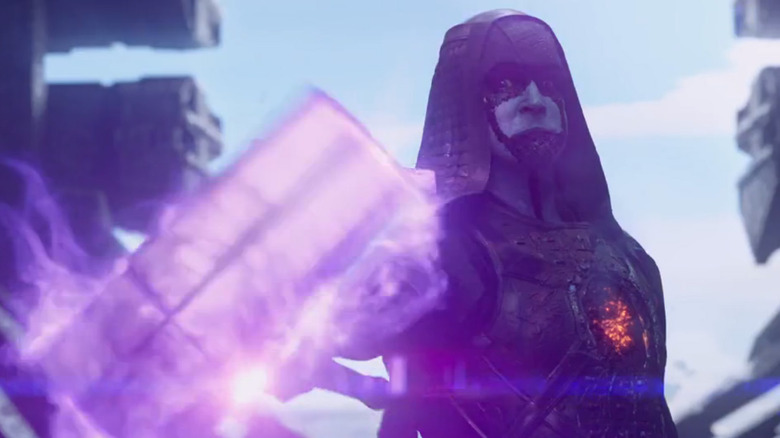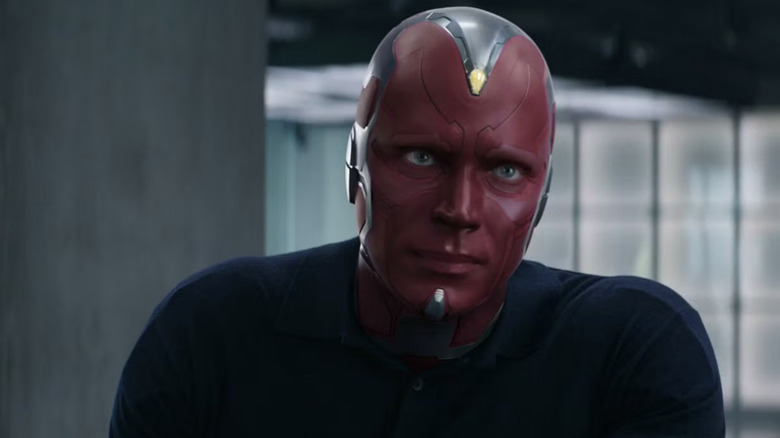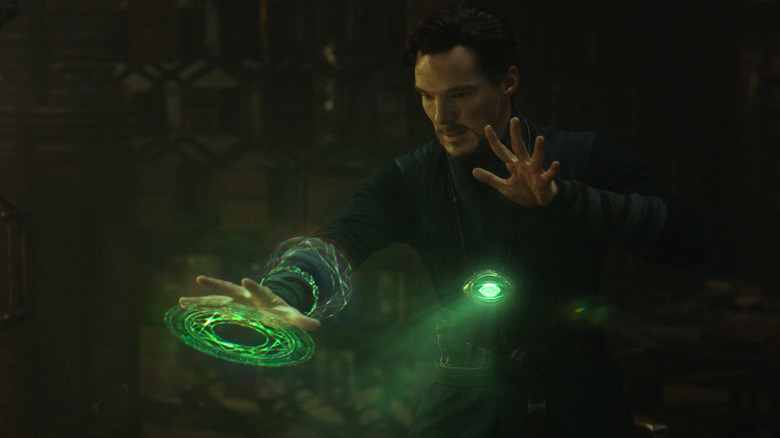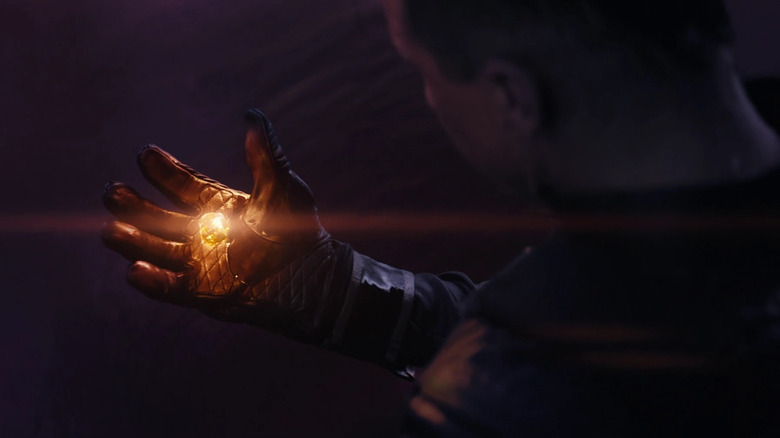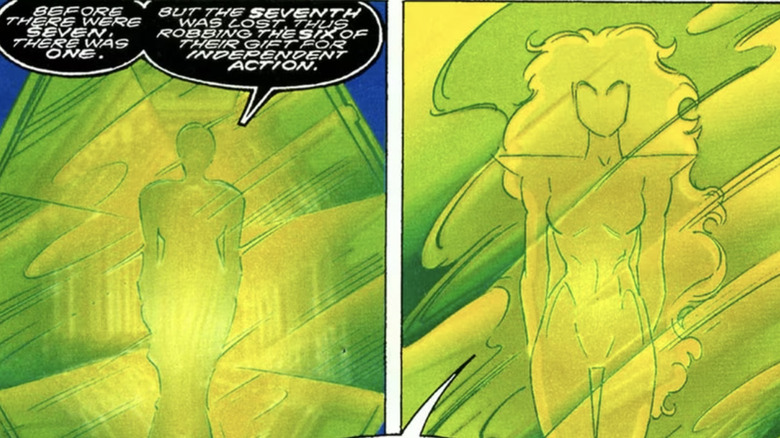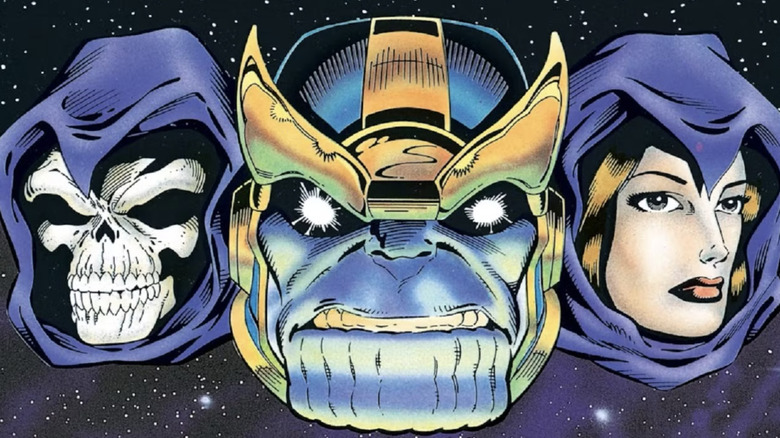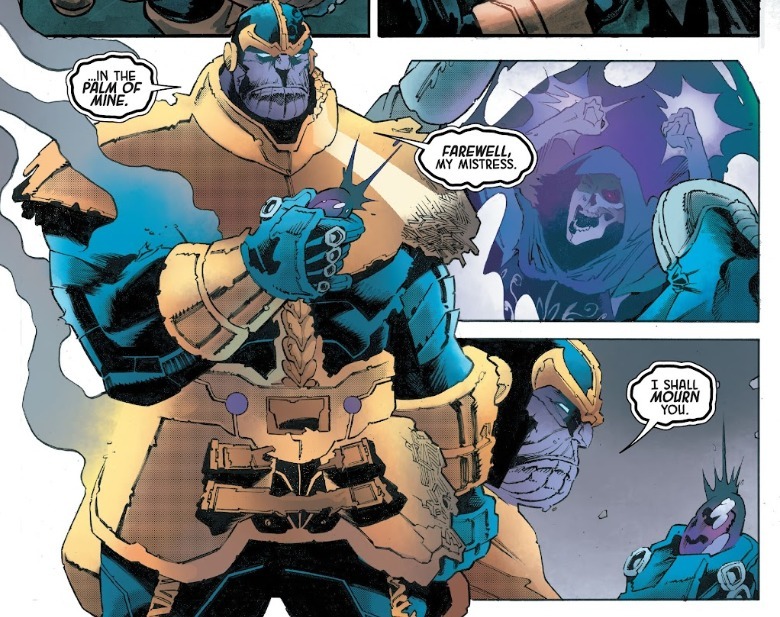We may receive a commission on purchases made from links.
Thanks to the Marvel Cinematic Universe, “Infinity Stone” is now a pop cultural shorthand. The six rainbow colored, cosmos-shaping Stones were slowly revealed movie by movie to be the primary MacGuffins of the MCU Phases 1-3. If you bring the Stones together (like, say, on a golden gauntlet) then you can wield all of their power simultaneously and become a god. That is exactly what Thanos the Mad Titan (Josh Brolin) plans to do so that he can kill half the universe with a finger snap.
The Stones all have pretty simple and intuitive names, reflecting what aspect of the universe they control: Space, Time, etc. Those names are the same as they are in Marvel Comics, though there the artifacts have different colors and are typically known as Infinity Gems.
The most famous comic with the Infinity Gems is 1991’s “The Infinity Gauntlet,” by Jim Starlin, George Pérez, and Ron Lim, which “Avengers: Infinity War” and “Avengers: Endgame” loosely adapted. When Marvel Studios kicked off the MCU, and didn’t have access to “Spider-Man,” “X-Men,” or “Fantastic Four” characters (so no Magneto, Doctor Doom, or Galactus), Thanos was probably the biggest villain they did have. So, making him the “big bad” was the natural choice, especially since they could spin a multi-movie arc around introducing the Infinity Stones, one-by-one, then uniting them for a grand finale.
So, how do the cinematic Infinity Stones compare to the original Infinity Gems?
Thanos and his history with the Infinity Stones, explained
The Infinity Gems originate with Marvel writer/editor Roy Thomas. In 1971’s “Marvel Premiere” #1 (drawn by Gil Kane), the artificial human once called “Him” is taken in by the High Evolutionary, who gives him a new name — Adam Warlock — and a “Soul Gem” to adorn his forehead.
A few years later in 1975, writer Steve Englehart introduced the idea of there being six Soul Gems. In a storyline from “Captain Marvel” #41-46, the Kree Supreme Intelligence tries to seize one of the Gems (retroactively labeled the Mind Gem). That pays off in 1977 in a two-part story sometimes called “The Final Threat.” Starlin, the writer/artist who created Thanos and finally made Adam Warlock a star, decided to bring his cosmic characters to an epic finale.
In “Avengers Annual” #7 and “Marvel Two-In-One Annual” #2, Thanos unites the six Soul Gems into one, giant, star-destroying Gem. This scheme ends with Warlock dead, Thanos petrified as stone, and the Gems seemingly destroyed.
Thanos stayed dead for many years, but Starlin eventually decided to resurrect his creation. In 1990’s “Silver Surfer” #34, Thanos returned. That led to two-part mini-series “Thanos Quest,” where he collects the six Soul Gems from the Elders of the Universe. This is when he renames them the Infinity Gems, fashions them into a Gauntlet, and prepares to finger-snap half the universe to death.
The key difference that should be clear by now is that, unlike the movies, the individual Infinity Gems were never that important in the comics. They weren’t slowly introduced one by one; all that mattered was Thanos bringing them together. “The Infinity Gauntlet” itself begins with Thanos having already gathered the Gems together. The movies gave each individual Gem/Stone greater focus to create a sense of culmination once Thanos did pull all of them together. In the process, the MCU merged many other artifacts with the Infinity Gems/Stones.
The Space Stone is the ultimate teleportation tool
Stan Lee and Jack Kirby introduced the Cosmic Cube in “Tales of Suspense” #79. Created by the mad scientists at Advanced Idea Mechanics (A.I.M.), it can grant any wish to those who hold it. The evil Red Skull tries to wield it, but is defeated by Captain America.
A MacGuffin that predates the Infinity Gems, the Cosmic Cube (now given a more prestigious name, “The Tesseract,” referring to a four-dimensional cube) was the driving force of the MCU’s Phase 1. It first appears in S.H.I.E.L.D.’s possession during “Thor.” Then, “Captain America: The First Avenger” revealed that the Red Skull (Hugo Weaving) wielded it during World War 2 to develop advanced energy weapons. In “The Avengers,” Loki (Tom Hiddleston) comes to Earth to claim the Tesseract, and uses it to open a wormhole and send a Chitauri army raining down upon New York City.
The Tesseract’s vague powers are recontextualized in “Thor: The Dark World” when it’s revealed to be an Infinity Stone. Specifically, the Space Stone. That’s why the Tesseract opens portals. Even its habit of disintegrating people can be reintrepreted as just displacing them (or, alternatively, dispersing their atoms). As the Space Stone controls space itself, it can move any object to any point of the user’s desire. Want to go halfway across the world? The Space Stone can get you there in an instant.
When the Red Skull touches the cube in “The First Avenger,” it opens the cosmos above him and teleports him away. (The Skull does not return until “Avengers: Infinity War” and “Endgame,” when he’s become a wraith.) Throughout “The Avengers” the Tesseract is often shown to open wormholes, from the opening scene where Loki uses its power to come to Earth onward. During “Infinity War,” when Thanos crushes the cube container and adds the Space Stone to his Gauntlet, Tesseract-portals become his go-to mode of transportation.
The Reality Stone binds the fabric of the universe to your wishes
In making the Cosmic Cube the Space Stone, the MCU removed the object’s traditional wish-granting powers. Those were transferred onto a different MacGuffin, the Reality Stone, because that Stone is all about altering reality. Think of its powers like hard light holograms: artificial and illusory, but with physical presence. In “Infinity War,” Thanos rearranges the appearance of the Collector’s (Benicio del Toro) to lure the Guardians of the Galaxy into a trap. Gamora (Zoe Saldaña) stabs a Thanos in the neck, only for that to be revealed as a puppet conjured by the real Thanos, who appears from behind a retreating veil of red particles. When Drax (Dave Bautista) charges Thanos, Thanos makes him and Mantis (Pom Klementieff) fall to pieces. When Star-Lord (Chris Pratt) tries to fire his gun, Thanos makes bubbles shoot out of it.
The Reality Stone first appears in “Thor: The Dark World” as the Aether (which is not a name it was previously known by in Marvel Comics, nor the name of an unconnected artifact). The Dark Elf Malekith (Christopher Eccleston) wants to use the Aether to fulfill his greatest wish: extinguishing all light from the universe. In the MCU, the Reality Stone appears as a floating liquid rather than a mineral, to reflect the instability of its power and how reality is always shifting in its presence.
The Power Stone grants unlimited power
All of the Infinity Stones are objects of power, but the most raw and untamed power comes from, well, the Power Stone. Debuting in “Guardians of the Galaxy,” the Stone is held in an orb container on planet Morag until being retrieved by Star-Lord. That kicks off a chase as numerous interested parties try to claim the orb — including the fanatical Kree named Ronan the Accuser (Lee Pace, who originally wanted to play Star-Lord). Ronan wants to destroy planet Xandar rather than accept its peace treaty with the Kree government.
When you touch the Power Stone, it charges you with its power. For mortal beings, that is too much power for their bodies to handle, so they slowly disintegrate and then explode. But if you can contain that power, you can redirect it.The Celestial Eson the Searcher is shown to have wielded the Stone in his staff and used it to incinerate a whole planet’s surface.
Ronan tries to do the same; he embeds the Power Stone in his war hammer, which turns the hammer into an energy blaster. Ronan’s final goal is to symbolically “cast judgment” on Xandar by slamming his hammer down on the planet’s surface and unleashing a shockwave to destroy it. He is, of course, foiled by the Guardians, who come together to split the Stone’s power between them and vaporize Ronan.
The Mind Stone controls the minds of all beings
During “The Avengers,” Loki wields a golden scepter adorned with a blue gem that can brainwash people to his will. S.H.I.E.L.D. keeps it after Loki is defeated.
In “Avengers: Age of Ultron,” the blue gem in the scepter is revealed to contain a smaller yellow gem, the Mind Stone. (You can’t have two Stones in the set being the same color, after all. “The Avengers” itself does treat Loki’s scepter as connected to the Tesseract, but more like an extension of its power. Regardless of whether it being the Mind Stone was planned during “The Avengers,” its mind control powers sure were a convenient fit.)
In “Age of Ultron,” Tony Stark and Bruce Banner use the consciousness of the Mind Stone as a blueprint to build an artificial intelligence, Ultron. When Ultron instantly goes rogue, he takes Loki’s scepter with him and tries to install the Mind Stone into a humanoid body for himself. The Avengers steal that body, combine it with the friendly AI JARVIS (Paul Bettany), and create the Vision.
Vision has the Mind Stone affixed to his forehead, which is why Thanos has to rip it out to complete his Gauntlet in “Infinity War.” Though the Stone is literally and symbolically Vision’s own mind (it’s on his forehead, close to where his brain would be), Vision never uses the Mind Stone’s powers like a telepath would. Instead, he mostly just fires yellow laser beams from his forehead with it.
The MCU Mind Stone, in being so integral to Ultron and Vision’s existences, stands in for some of their comic features. In the comics, the yellow gem in Vision’s forehead merely absorbs solar energy to power his body. Him having an Infinity Stone in his forehead is closer to Adam Warlock’s adornment with the Soul Stone. Comic Ultron also has an “encephalo-ray,” a tool which can brainwash humans or shut down their minds entirely, placing them in comas. In the movie, he instead uses Loki’s scepter for that.
The Time Stone allows time control and travel
If you want to be a God, you can’t just travel long spatial distances — you must also bend time to your will. Enter the Time Stone. The Stone can reverse time, make it leap forward, create localized or larger time loops, and more.
In “Doctor Strange,” Stephen Strange (Benedict Cumberbatch) uses the Time Stone to basically create a “save point” for himself before he confronts Dark Dimension lord Dormammu (voiced by Cumberbatch). Whenever Dormammu kills Strange, the Time Stone resets to moments before, when Strange first greets Dormammu, time and time again. But they both retain their full memories of every loop, so even an eldritch being like Dormammu loses patience and surrenders to Strange’s terms.
The MCU merged the Time Stone with the Eye of Agamotto, an amulet and one of Doctor Strange’s trademark magical instruments. The Eye in the comics is more of a general spell-casting artifact, though true to its “Eye” moniker it is especially useful for unveiling illusions. The MCU switches the Eye’s power set to be exclusively about controlling time.
Of the MCU films that center around Infinity Stones, “Doctor Strange” does the best job of using the MacGuffin for a greater purpose. Time is the whole theme of “Doctor Strange” — the evil Kaecilius (Mads Mikkelsen) believes, like poet Delmore Schwartz, that “time is the fire in which we burn.” He wants to bring the Dark Dimension and Earth together because the former realm has no linear time, and thus no death. While Strange wields the Time Stone, the way he uses it against Dormammu is all about submitting himself before the power of time and death.
The Soul Stone holds souls (and a pocket dimension)
The Soul Gem was the first of its kind to appear in Marvel Comics, but the Soul Stone is the last of the Stones to appear in the MCU. The movies don’t really demonstrate what powers the Soul Stone actually has, instead focusing on a ritual to obtain it. On planet Vormir, one must sacrifice a loved one’s life to obtain the Soul Stone (“a soul for a soul”). In “Infinity War,” Thanos throws Gamora to her death to get the Soul Stone. In “Endgame,” Black Widow (Scarlett Johansson) throws herself to her death so Hawkeye (Jeremy Renner) and the other Avengers can get the Soul Stone.
(Both movies depict Thanos and Hawkeye awakening in a shallow pool with a black sun in the background, finding the Soul Stone in their hand. Given the theme of sacrifice and visual similarities, that’s likely a homage to the manga/anime “Berserk,” when mercenary leader Griffith decides to make a terrible sacrifice to attain godhood in a similar scene.)
The comics depict the Soul Gem’s abilities in more detail. As the sacrifice ritual would suggest, the Stone’s powers are over the living and the dead. It can hold the souls of living beings, and an Eden-like pocket dimension exists inside the Gem to house them. When Warlock and co. “died” during “The Final Threat,” their souls lived on inside the Gem, and then they emerge from the Gem to again oppose Thanos in “The Infinity Gauntlet.”
The movies allude to this pocket dimension when Thanos, having snapped his fingers to wipe out half the universe, sees a young Gamora (Ariana Greenblatt) in an orange void. But “Endgame” doesn’t really follow up on that.
Don’t worry about the Ego Gem
One of the best comic podcasts right now is “Cerebro,” in which host Connor Goldsmith and his guests (including many Marvel Comics writers) go through the history of “X-Men,” one character at a time. Each episode has a segment where Goldsmith reads a scripted biography of the character the episode is focusing on, so as to bring listeners without encyclopedic knowledge up to speed. Whenever he gets to a reviled or forgotten story, he tends to quip, “Don’t worry about it.”
That right there is the attitude comic fans can and should take with canon. Acclaimed Marvel writer Jonathan Hickman, on episode 101 of “Cerebro” (about Apocalypse), said that continuity is not every story that’s ever been published, it’s the stories that people remember.
Something a lot of people don’t remember is the “Ultraverse,” a 1990s publishing imprint by Malibu Comics, a company that was purchased by Marvel in the mid-’90s. Writer Hank Kanalz and artist Mike Zeck tied the Infinity Gems to this setting in 1995 on the series “Eliminator.” Long ago, the Gems were one, then they split into seven aspects. Yes, seven, because an Ego Gem (holding the essence of the all-powerful Nemesis) was lost in the Ultraverse eons ago. In “Ultraforce/Avengers” #1, the seven Gems are brought together and Nemesis is resurrected, forcing the two titular teams together.
Yes, this story and lore about the Infinity Gems is technically canon. But most later stories, including the MCU, do not include the details it established about the Infinity Gems. “The Infinity Gauntlet” is the ur-text about the Infinity Gems, so that’s what gets adapted and what fans should pay attention to.
Thanos haș created a new Infinity Stone that holds the power of Death
More recent Marvel Comics have been depicting the Infinity Gems closer to the movies. They’ve been reassigned their MCU colors, are now called Infinity Stones, and stories like “Infinity Watch” are putting more importance on the individual Gems as uniquely powerful artifacts in their own right.
But one thing Marvel Comics thankfully hasn’t changed is why Thanos wants the Gems. In the MCU, he’s obsessed with “balance” and thinks that culling populations will prevent resource exhaustion. But comic Thanos is not a Malthusian radical centrist: he’s a Byronic incel and serial killer literally in love with Death herself. Killing half the universe? That’s his version of an engagement present, but even after that, Death pays him no mind.
If Death will not give herself to him, Thanos has decided, he will take her. In the 2023 “Thanos” mini-series by writer Christopher Cantwell and artists Luca Pizzari and German Peralta, Thanos captures Death and imprisons her in an artificial Infinity Stone. The black Death Stone contains the life destroying/absorbing powers of its prisoner.
Thanos would’ve once given all six Infinity Stones to win Lady Death’s heart. Now, she’s just one more gem in his collection.


